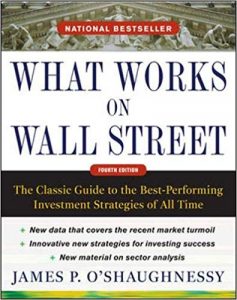Review What Works on Wall Street
by JAMES P. O’SHAUGHNESSY
Description
This book is a culmination of the best investment strategies that revolve around Wall Street for the past fifty years. It delves into the nature of these strategies and what cuts them apart from unsuccessful investment strategies.
This book is filled with data, analyses, and charts that will help the reader compare and contrast the results of each investment strategy when it was used. This is an updated version of investment strategies fitting to the current landscape of finance.
The first edition of this book was a breakthrough in the area of backtesting investment strategies, and it paved the way for common knowledge about the performance of many well-known strategies. In this edition, the update, added to the original content, attempts to link backtesting to the current market conditions. Although many investors and traders are already used to the idea of backtesting before using a strategy, this book is still relevant as it establishes which strategies are mostly used today.
That being said, the charts and data compiled and tested by O’Shaughnessy tend to divert. Overall, it seems unorganized and inconsistent. The length of the book is mainly reliant on the charts and graphs with few analyses. However, this still does not take away the fact that this book is an important part of the modern investment landscape.
About the Author
JAMES P. O’SHAUGHNESSY is a senior managing director and the director of systematic equity at Bear Stearns Asset Management. He is the former chairman and CEO of Netfolio, Inc. His investment strategies have been featured in various publications, such as The Wall Street Journal, The Financial Times, and The New York Times.
Table of Contents
Preface
Acknowledgments
Chapter 1: Stock Investment Strategies: Different Methods, Similar Goals
Chapter 2: The Unreliable Experts: Getting in the Way of Outstanding Performance
Chapter 3: Rules of the Game
Chapter 4: Ranking Stocks by Market Capitalization: Size Matters
Chapter 5: Price-to-Earnings Ratios: Separating the Winners and the Losers
Chapter 6: Price-to-Book Ratios: A Better Gauge of Value
Chapter 7: Price-to-Cashflow Ratios: Using Cash to Determine Value
Chapter 8: Price-to-Sales Ratios: The King of the Value Factors
Chapter 9: Dividend Yields: Buying an Income
Chapter 10: The Value of Value Factors
Chapter 11: Do High Earnings Gains Mean High Performance?
Chapter 12: Five-Year Earnings-per-Share Percentage Changes
Chapter 13: Profit Margins: Do Investors Profit from Corporate Profits?
Chapter 14: Return on Equity
Chapter 15: Relative Price Strength: Winners Continue to Win
Chapter 16: Using Multifactor Models to Improve Performance
Chapter 17: Dissecting the Market Leaders Universe: Ratios That Add the Most Value
Chapter 18: Dissecting the Small Stocks Universe: Ratios That Add the Most Value
Chapter 19: Searching for the Ideal Value Stock Investment Strategy
Chapter 20: Searching for the Ideal Growth Strategy
Chapter 21: Uniting Strategies for the Best Risk-Adjusted Performance
Chapter 22: New Research Initiatives
Chapter 23: Ranking the Strategies
Chapter 24: Getting the Most Out of Your Equity Investments
Appendix
Bibliography
Index
